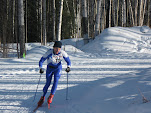The Great US Nationals Freeze Out

------------------------------------------------------
Key for the chart:
Green = good conditions
Yellow = skiing is 'marginal' but a go
Orange = proceed with caution
Red = find a different outdoor activity or stay home
-------------------------------------------------------
For the third time in four days the 2009 US national championships for cross country skiing have been frozen out in Anchorage. At this point we don't even know what's ahead in the schedule, what races are planned for today or tomorrow, or even if more races will be held this week.
Is this good for the sport? Does the -4 F (-20 C) temperature rule even make sense? Well, living in Fairbanks for five years (and in my case North Dakota and Northern Minnesota for another five, not to mention decades in the Rockies) here is some unabashed expert opinion.
To answer the first question, No this can't be good for Nordic skiing in North America. It's an obscure sport to begin with and people like order. This is chaos.
As for the somewhat arbitrary -4 cutoff, there is no doubt an increased risk of frost bite as temps dip below zero, and heavy exercise in frigid temps does result in some respiratory distress. But, from experience and observation, there is nothing magical about -4. Here in Fairbanks, where the population is a little out of whack anyway, adults race down to -20 F, and kids will still compete to -10 F in the local Town Race Series.
In my years here, I've seen an heard of a couple mild cases of frostbite, and I've gotten a little on my cheek at a couple races. Regarding respiratory distress--and I'm going purely on personal experience here--as a lifetime asthmatic, I have been able to race down to -20 F without too much trouble. I once did a race at -26 F in Minnesota, and at that temp I was gagging on my on saliva and mucous. Not a good experience. I do have some bad days when it's really cold, but usually if I use the inhaler, pace myself, and don't go out too fast it's fine. Short races (10K and under) are actually tougher at that temperature.
Back in Colorado one year I developed a lingering dry hack for several weeks after racing at -10, but my worst experience from upper respiratory problems due to intense excercise was actually from running indoor track, at 70 degrees.
No doubt top level racers and coaches are concerned about upper respiratory infection--well I've caught exactly one winter cold since moving here in 2004, and I do a dozen ski races and four or five snowshoe races a year. Granted, elite skiers train and race on the edge of illness throughout much of the winter. To be that good you have to push your body to the extreme. To catch a cold or flu at this time of year can ruin an entire season for an athlete. But if there is any scientific evidence that says such setbacks are more likely at -6 compared to -3, I'd sure like to see it.
So what's a safe cutoff? That could be worth some studies, but I'd venture to guess that they could race down to -8 or even -10 without undue health risks, and they certainly could be going at it with the -6s and -7s they've had in Anchorage this week.


1 Comments:
HA!! That chart is a hoot. But dead-on, too.
As are your comments on racing in colder temps. Even as a lifetime New Englander, I'd say racing in -10F is reasonable, especially for classic races. I mean, I don't even think about putting on the lobster mitts til it's 5F or so, and don't feel any need for overboots unless it's below zero.
Perhaps the FIS temp rule should have a little discretion for wind. I'd sure as hell much rather race in 0F with no wind than 10 or 15F with gale.
Grambo
Post a Comment
Subscribe to Post Comments [Atom]
<< Home